Our Verdict
The NZXT N7 B550 is a solid, though not perfect debut AMD entry for the company. If you want an ultra-clean white themed build, there aren’t many options. NZXT's latest offers the slick look you'd want, but at a sadly high price for a B550 board.
For
- Clean good looks
- Wi-Fi 6E
- Lots of USB
Against
- Lacks M.2 drive cooling
- Pricey for a B550 board
PC Gamer's got your back
Well, here's something a bit different. A lot of current gen motherboards default to a mostly black theme, with splashes of RGB branding and logos. White themed motherboards do exist, but they are few and far between. NZXT's boards stand apart though, especially in their all-white garb.
NZXT might not have the motherboard brand recognition of the big players in the game, but it has released boards for the last few Intel generations. The N7 B550, however, is the company’s first AMD motherboard.
It's not some budget knock off, either. This is one of the most feature rich of all B550 motherboards, and indeed, it puts a lot of X570 boards to shame. But, should you consider one over a board from one of the big four though?
It's clear that ASRock is the partner manufacturer of the N7 B550; upon entering the BIOS for the first time, you're presented with a re-skinned ASRock BIOS. Not that there's anything wrong with that. ASRock's AM4 BIOS' might not include every option under the sun, but it means the N7 B550 is easy to navigate. NZXT's first motherboards came with a barely functional BIOS, and highlighted the company's naivety about this segment of PC hardware.
Users of NZXT coolers and cases will be familiar with the company's CAM software, however, for good or ill. In my opinion it's one of the better and more fully featured system control suites out there. It offers RGB and fan/AIO control, and even overclocking control.
At first glance you'll notice the shrouds that cover most of the board. We have the white version on hand. There are still lots of black highlights across the board including the PCB itself, the socket, slots, and rear I/O shroud. Perhaps NZXT should have gone all white, like it went all black with its sibling.
Also note that there's no RGB lighting on board, though there are RGB and ARGB headers onboard.
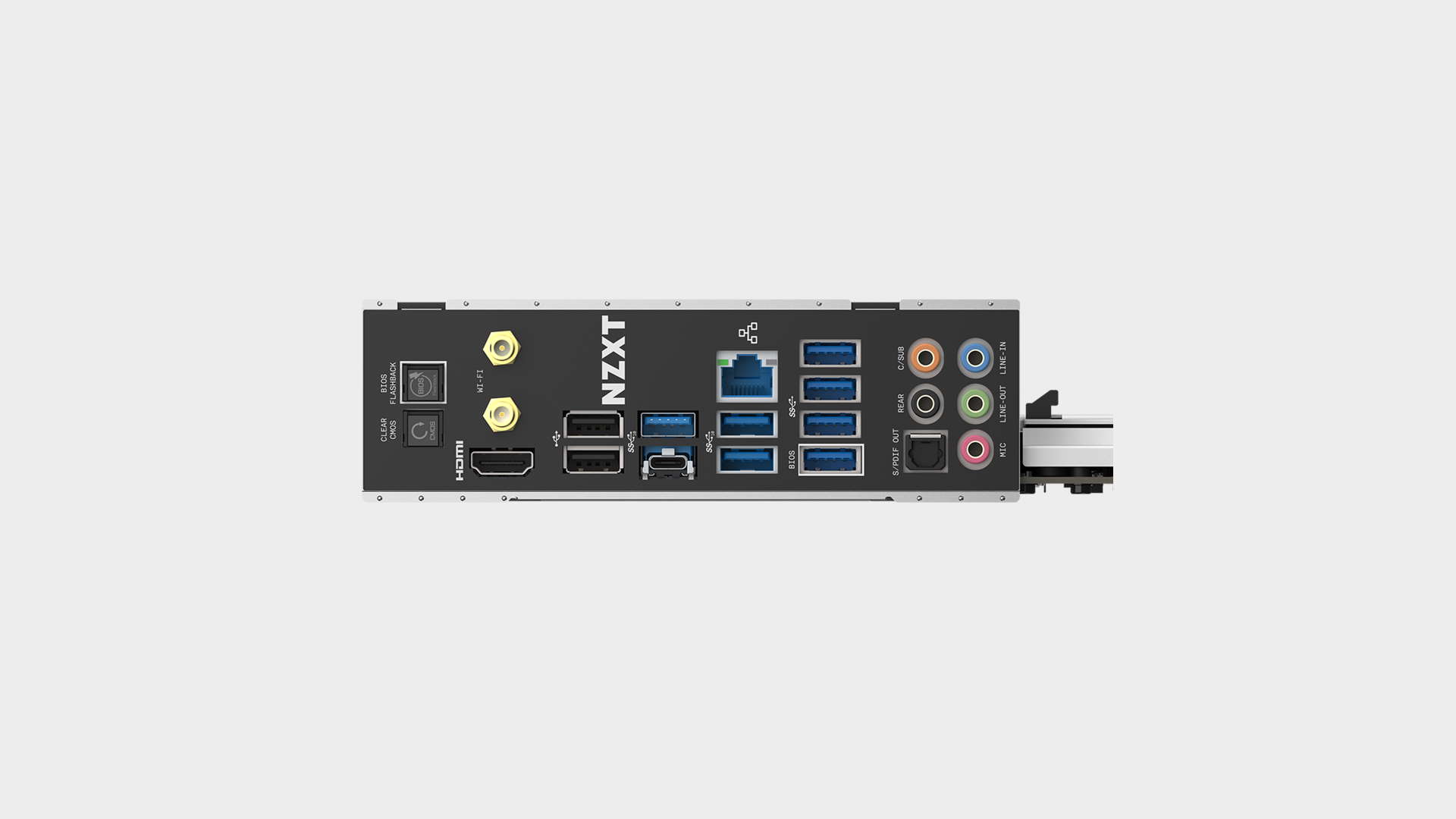
Form factor: ATX
Socket: AMD AM4
CPU support: AMD Ryzen 3000 (Except 3000 G Series), 4000, and 5000 Series Desktop Processors
Storage: 2x M.2; 6x SATA
USB: Up to 5x USB 3.2 Gen 2, 6x USB 3.1 Gen 1, 8x USB 2.0
Networking: AX210 Wi-Fi 6E; Realtek RTL8125BG 2.5G LAN
Audio: Realtek ALC1220 7.1 Channel HD Audio
Price: $250 | £250
The white shrouding could present a nice opportunity for modders. It’s like a blank canvas for any kind of design you can come up with. Though it does give the board a unique look, it's not without trade-offs. The magnetically attached M.2 slot covers lack any kind of M.2 cooling; something that's especially relevant with hot running PCIe 4.0 SSDs. Also note that the bottom slot runs at PCIe 3.0 x2 only, so you’ll be giving up some performance (and two of the six SATA ports) if you populate it. This implementation is the board's most obvious weakness.
Apart from the poor M.2 implementation, the board is otherwise packed with features.
A tour of the board reveals seven fan headers, a Type-C USB case header, power and reset buttons, and two USB 3.1 Gen 1 headers. These are placed adjacent to the six SATA ports. With care given to cable management, this is a board that will happily serve at the heart of the cleanest of gaming PC builds.
The VRM system is similarly capable for a board at this price. A 12+2 phase solution, with 50a chokes, will provide enough power for any conceivable overclock, even with a 5950X. Any concern we had regarding the cooling of the VRM was alleviated upon closer inspection. Underneath the white shrouding the heatsink is indeed large with lots of finned surface area. A quick test with our 5800X saw a peak VRM temp of 50°C with PBO enabled. That’s a good result.
The rear I/O is packed with ports, and it's one of the best examples you'll see on any B550 board. There’s a spot for Wi-Fi antennas, BIOS flashback (for flashing without a CPU), and CMOS clear buttons. There’s a welcome HDMI port for use with a brand new 5000G series APU. There’s a standard set of audio ports including S/PDIF, which is driven by an ALC1220 codec. Wired networking is provided by a 2.5G Realtek RTL8125G controller.
Finally, there’s the USB complement, which is top notch. There are ten USB ports, made up of Type-A and C USB 3.2 Gen 2 ports, six Gen 1 ports and two 2.0 ports. A 3.2 Gen 2x2 port would be nice, but things like that are how $500+ boards are somehow justified. With ten ports, you can plug in your chargers and printer, mice and keyboard, and USB head massagers all at the same time.
System performance
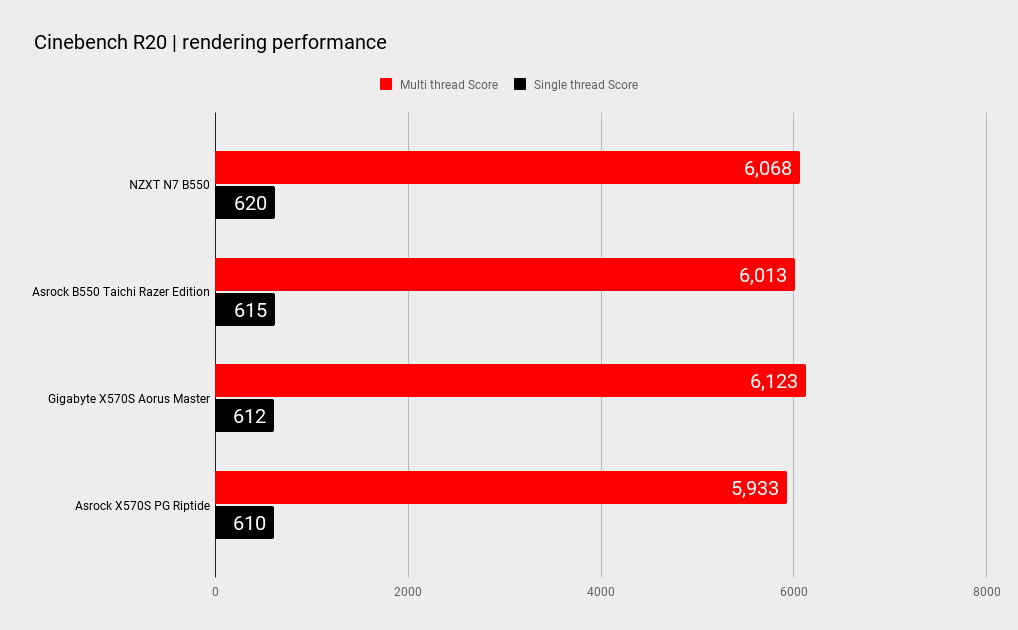
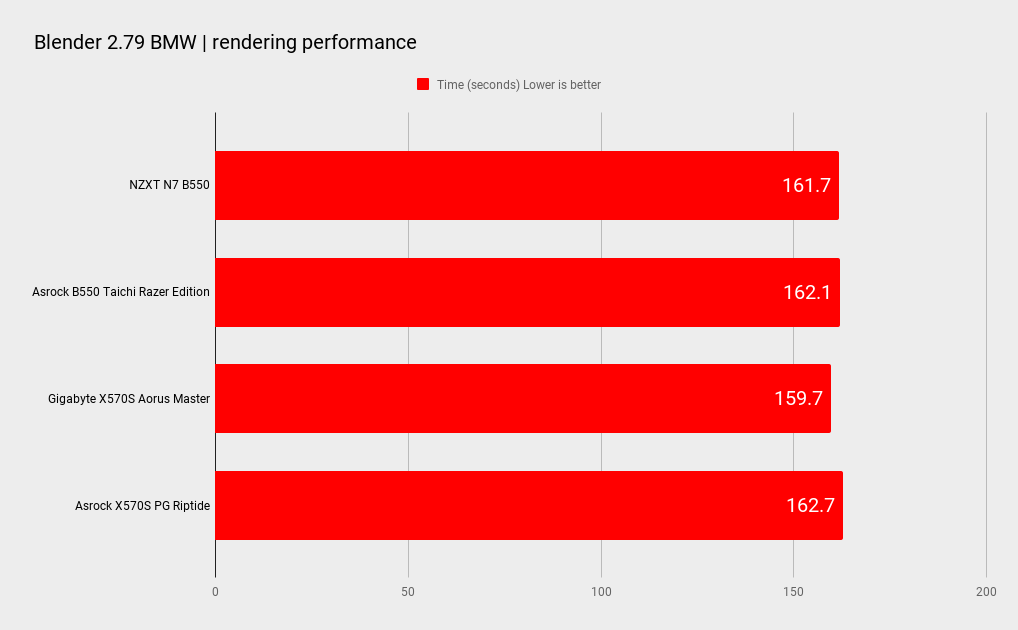
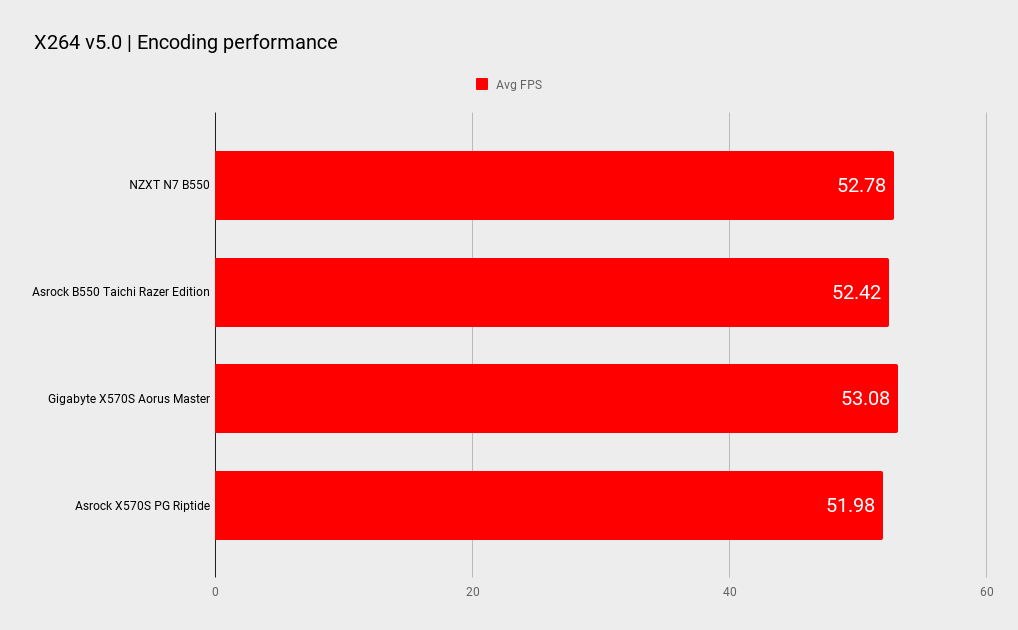
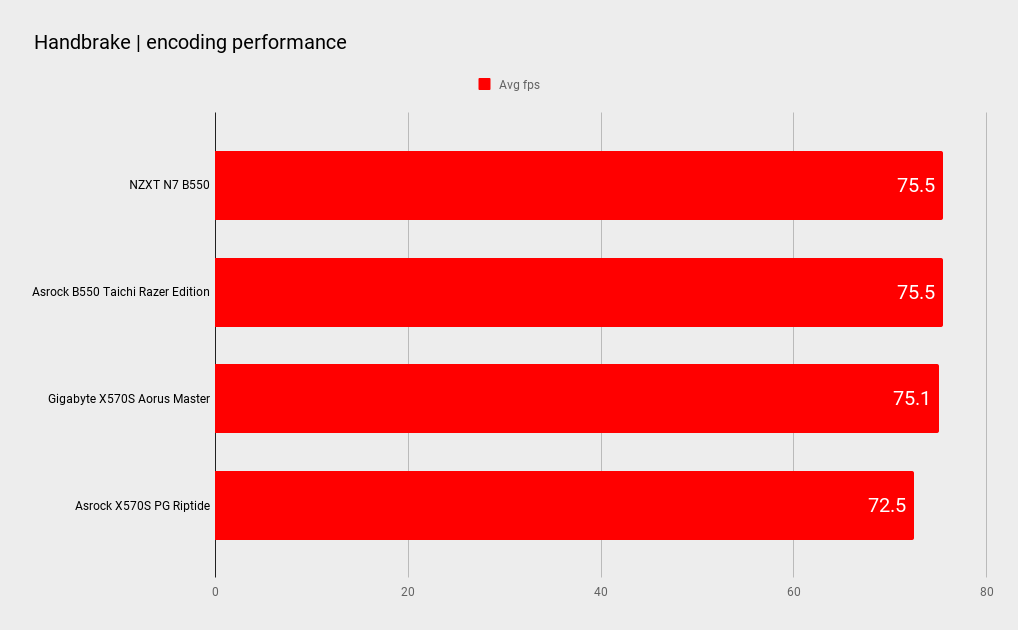
Gaming performance
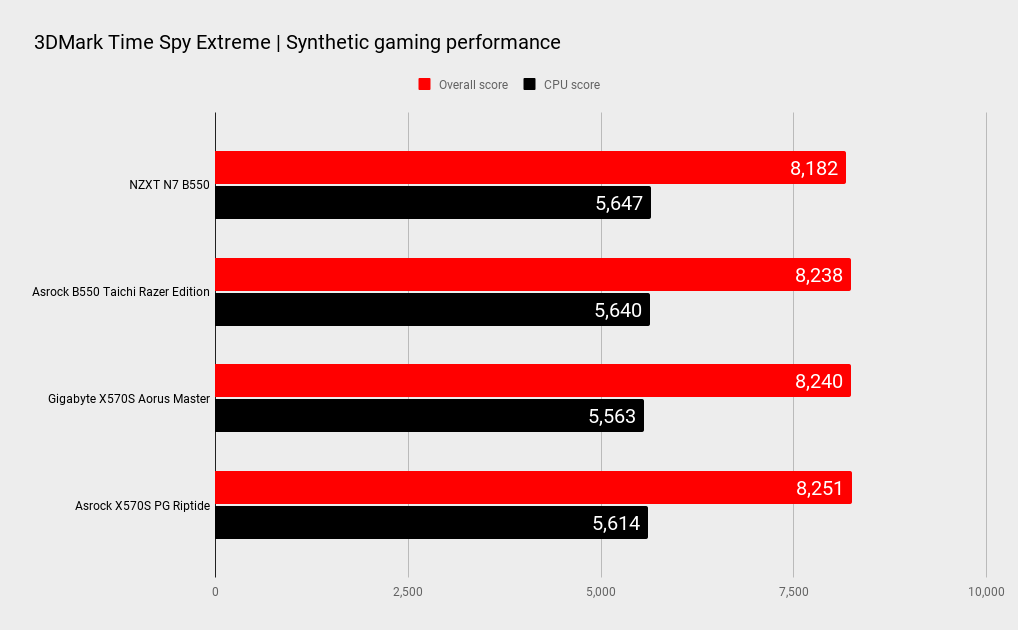
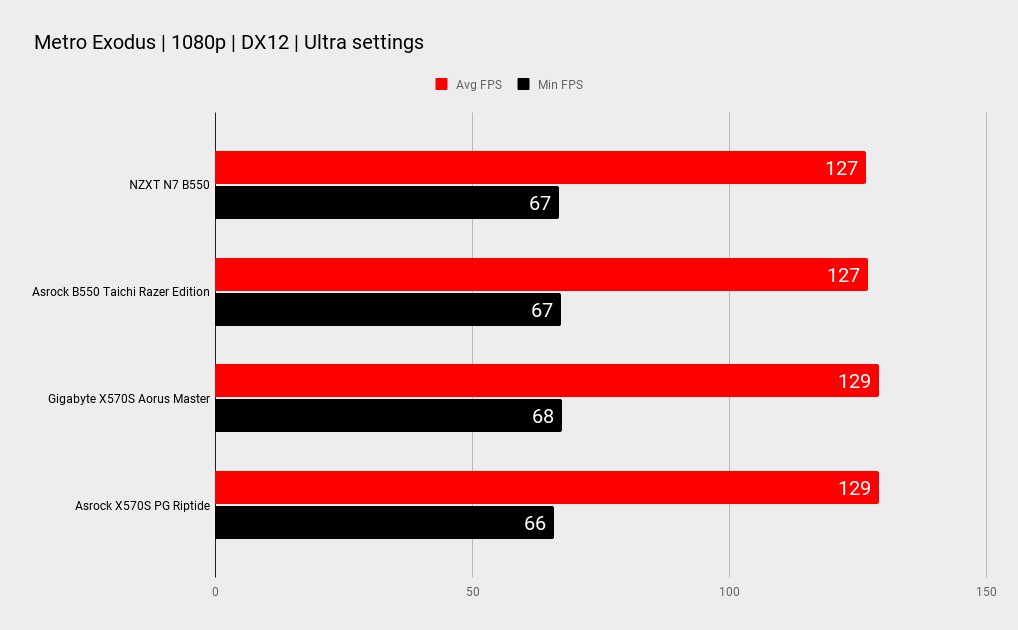
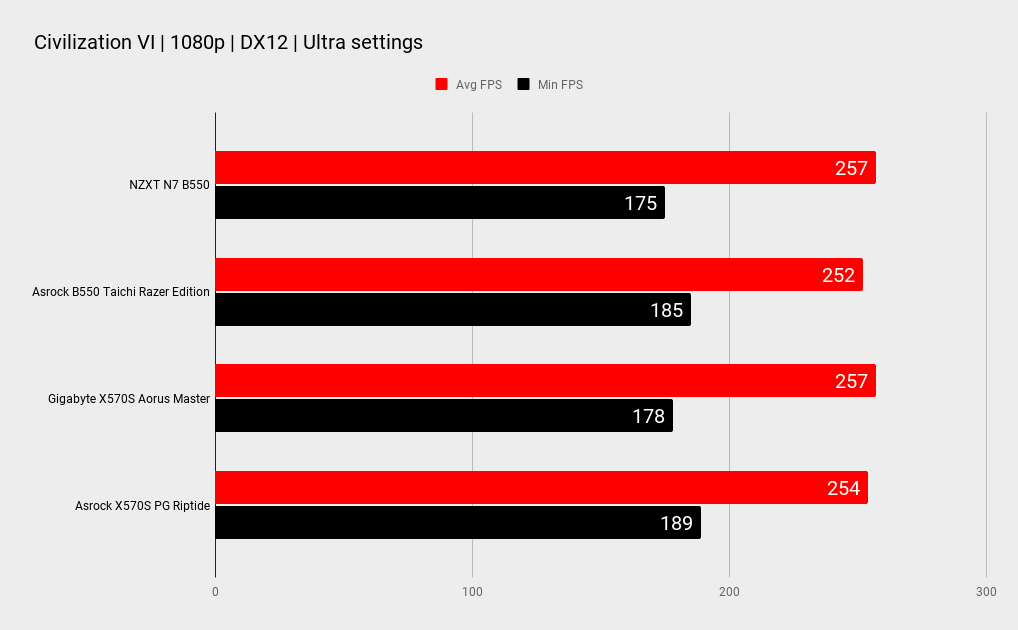
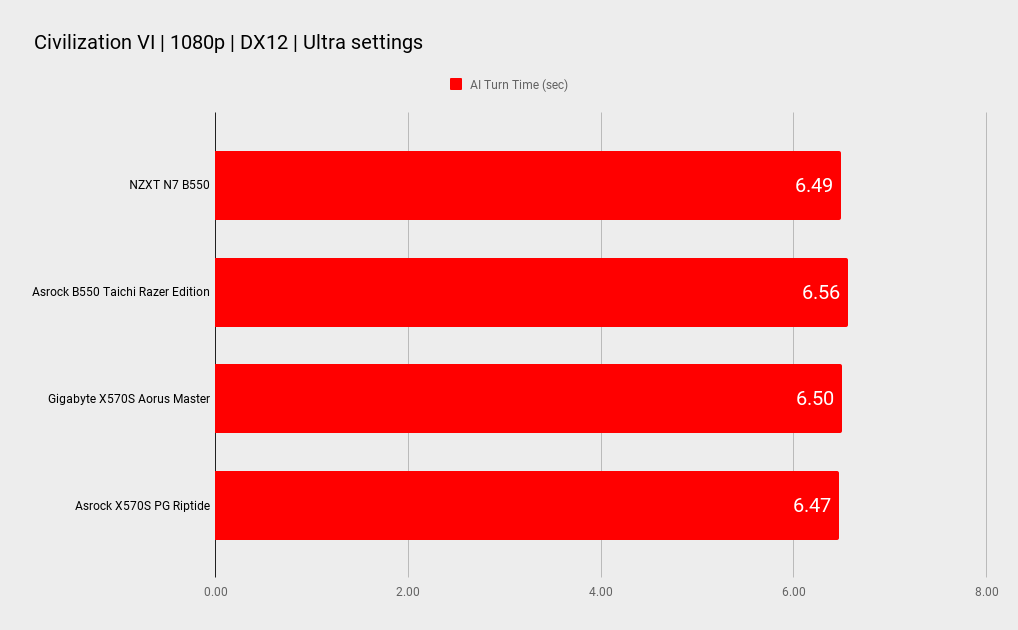
CPU: AMD Ryzen 7 5800X
GPU: MSI RTX 3080 Gaming X Trio
RAM: 16GB Teamgroup Xtreem ARGB @ DDR4-3600
Storage: 1TB Samsung 860 Pro, 500GB Samsung 980 Pro
Cooling: NZXT X73 360mm AIO
PSU: Corsair AX1000
Chassis: Thermaltake Core P8
The N7 B550 performed as we expected and perhaps a little better than that. Under a single threaded load, the board performed at the higher end of the tested AM4 boards. It’s no slouch under a heavy multi-threaded load either, in fact managing to beat out the high end Asrock B550 Taichi Razer Edition. Under gaming loads the burden remains on the GPU with margin-of-error levels of difference.
Overall though, the NZXT shows itself to be a mature offering when it comes to actual PC performance. Any worries we had that the board might lack a little polish here or there were quickly dispelled.
A quick and dirty overclocking test was easily handled by the N7 B550, with 2x 16GB sticks running at DDR4-3600 1:1, and PBO presenting zero challenge. But, when overclocking with a 2x 8GB kit, we should be able to push to 1,900MHz Infinity Fabric or higher, as we have done with this CPU sample before. But sadly we weren’t able to achieve stability. Your mileage may vary though. DDR4-3600 at 1:1 remains the AMD sweet spot and the N7 B550 won’t be any barrier to that.
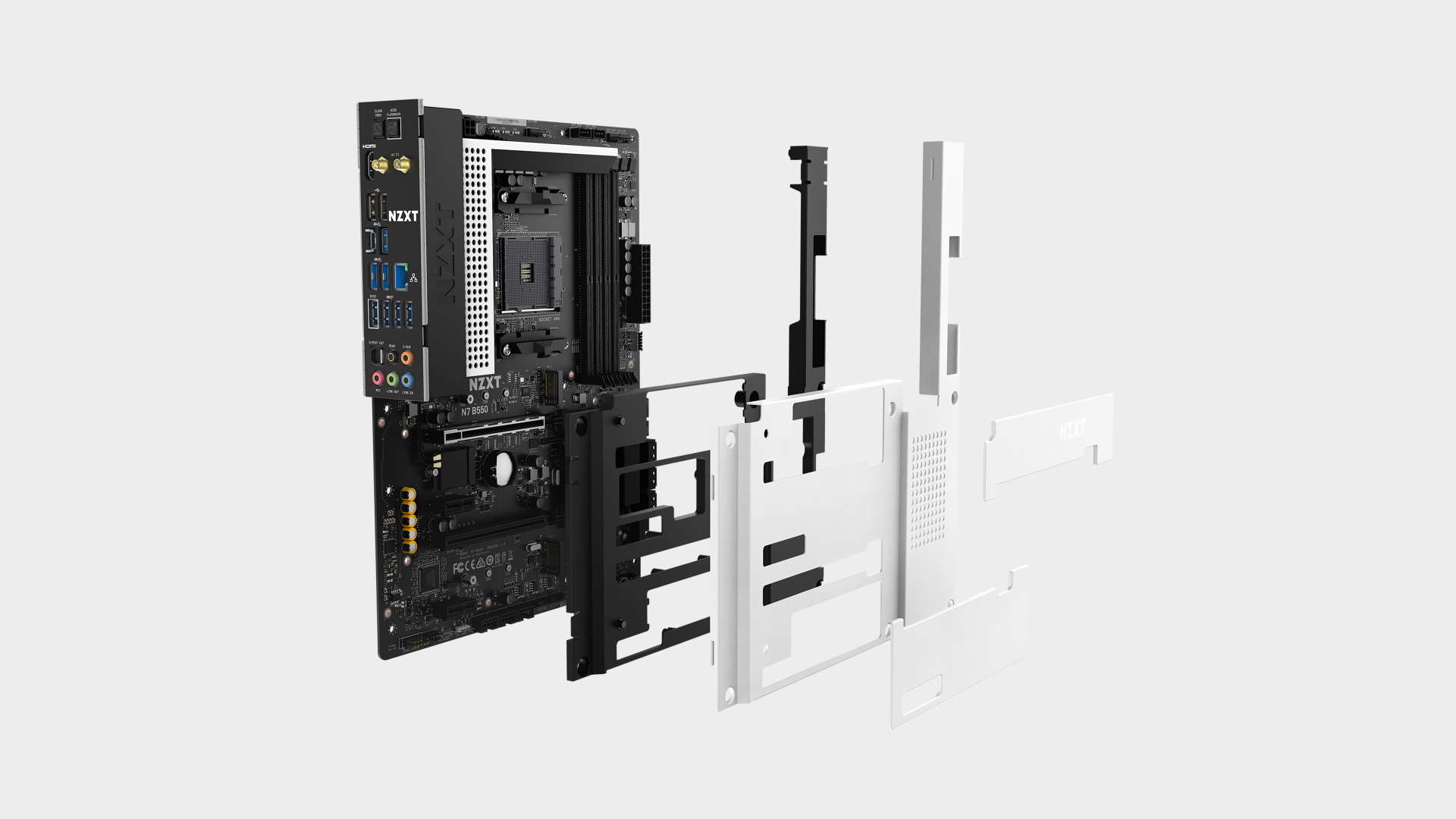
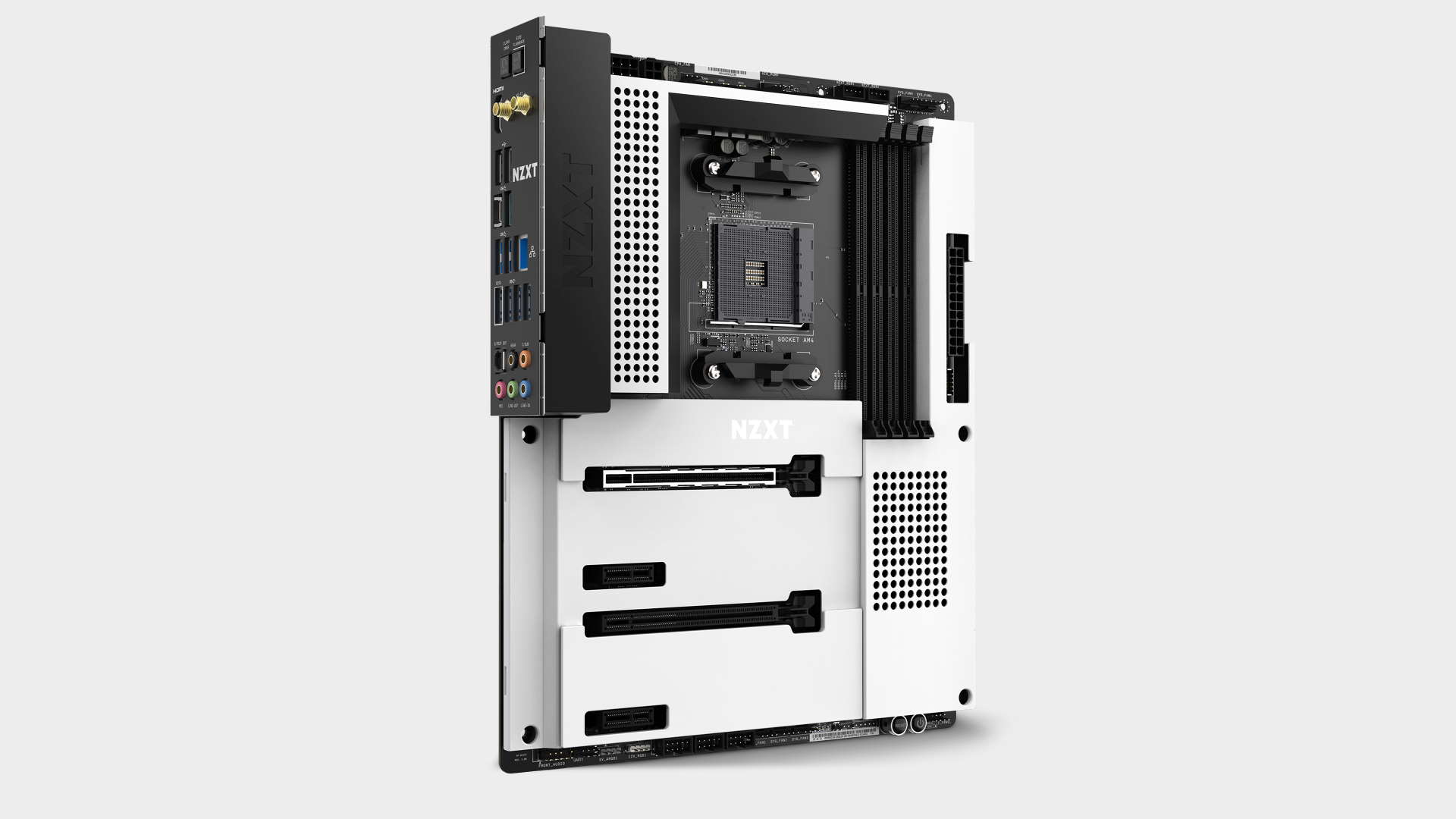
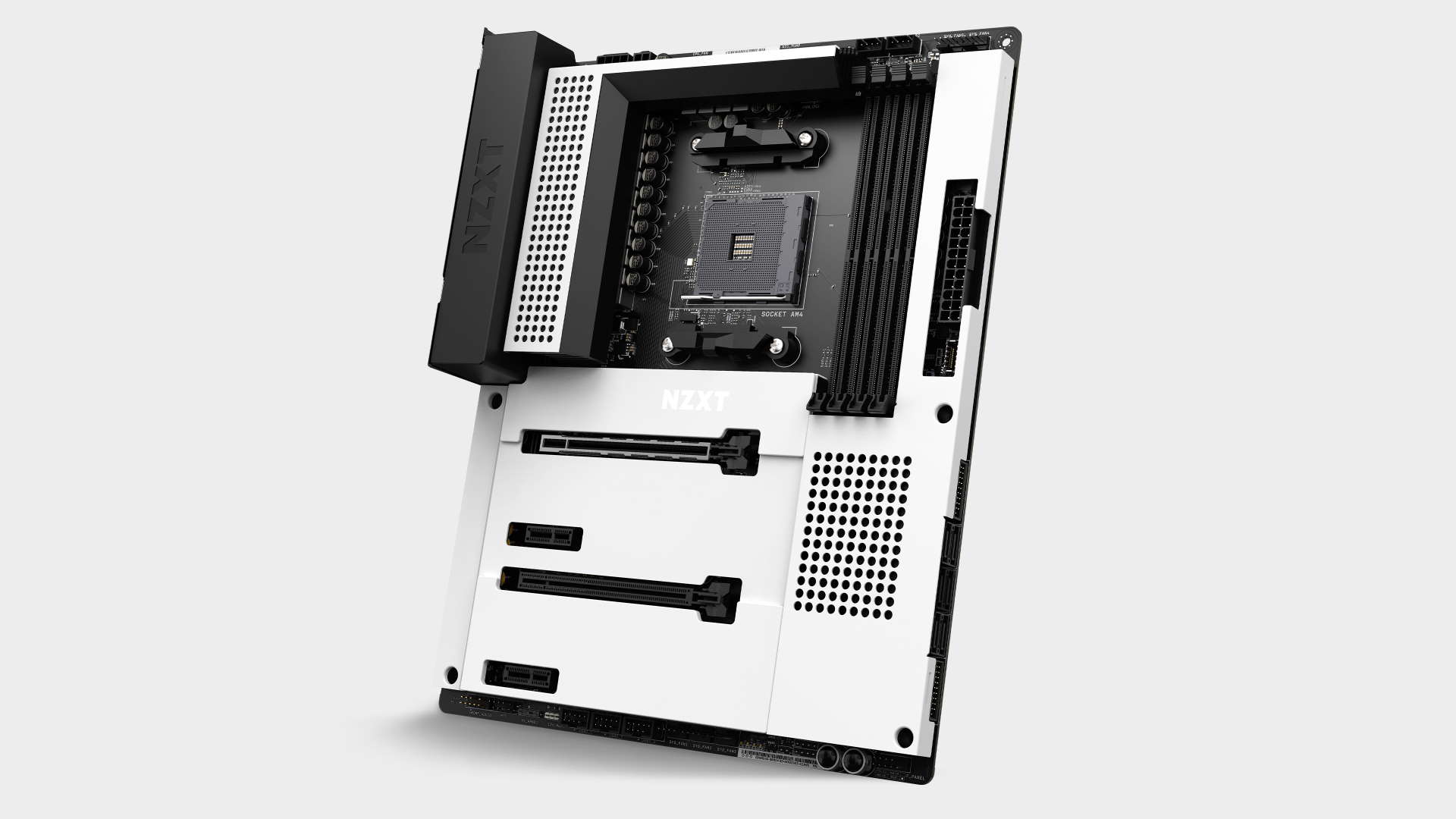
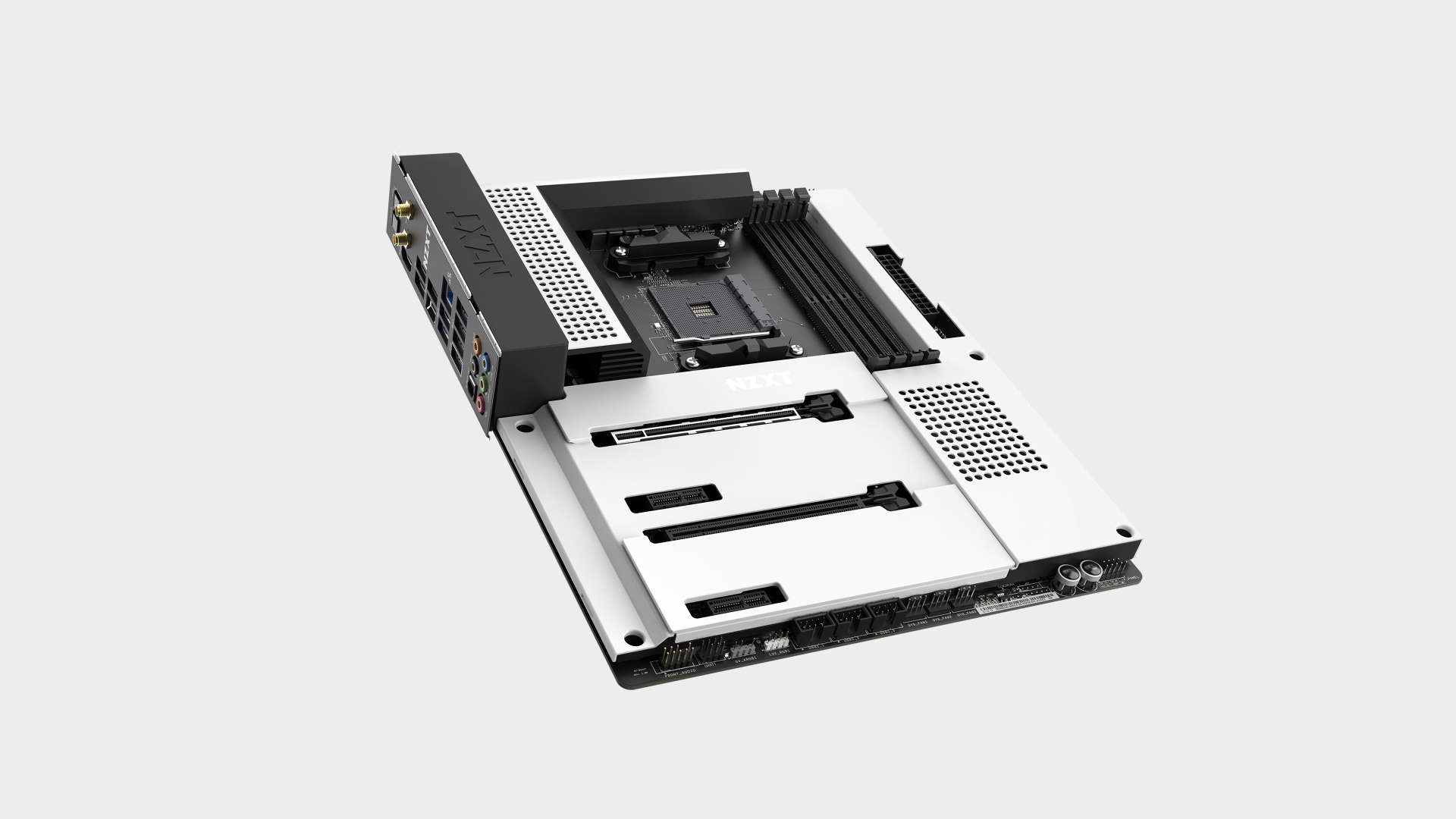
At the time of writing The NZXT N7 B550 is available from select US sellers for $249.99, which is higher than its $230 suggested retail price. This makes it one of the more expensive B550 boards. Normally we’d suggest that aesthetics aren’t too important when evaluating a motherboard—within reason. The NZXT N7 B550, especially the white version, is a board that might end up in your cart primarily because of its look.
There’s nothing wrong with that, as long as it does well in other areas, and it mostly does. A white build, with the right components and case, looks really clean, with or without RGB lighting. We do wish it was all white though.
So, NZXT's N7 B550 has performance that's solid, is one of few B550 boards with Wi-Fi 6E, has got a great USB complement, and despite our misgivings about the effect of the shrouds on temperatures, it's a very cool running board.
The N7 B550 is a successful first AMD entry for the company, but it has a flaw that we hope will be addressed. It’s M.2 implementation is poor, with no drive cooling, only two slots and the second slot is slow and shared between SATA ports. Its not a deal breaker, but if you run a load of drives, you’ll have to look elsewhere. With the right partnering components though, this is a rather stunning looking board. With its fast Wi-Fi, strong feature set, it will look right at home in a white themed build.
The NZXT N7 B550 is a solid, though not perfect debut AMD entry for the company. If you want an ultra-clean white themed build, there aren’t many options. NZXT's latest offers the slick look you'd want, but at a sadly high price for a B550 board.

Chris' gaming experiences go back to the mid-nineties when he conned his parents into buying an 'educational PC' that was conveniently overpowered to play Doom and Tie Fighter. He developed a love of extreme overclocking that destroyed his savings despite the cheaper hardware on offer via his job at a PC store. To afford more LN2 he began moonlighting as a reviewer for VR-Zone before jumping the fence to work for MSI Australia. Since then, he's gone back to journalism, enthusiastically reviewing the latest and greatest components for PC & Tech Authority, PC Powerplay and currently Australian Personal Computer magazine and PC Gamer. Chris still puts far too many hours into Borderlands 3, always striving to become a more efficient killer.

